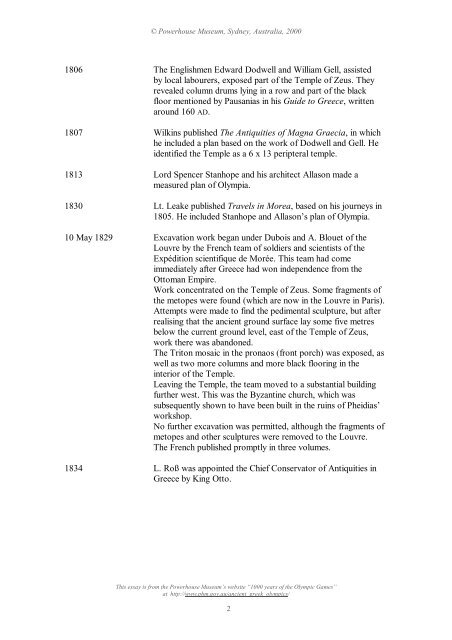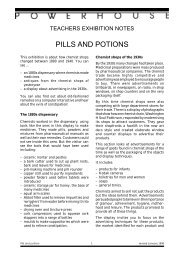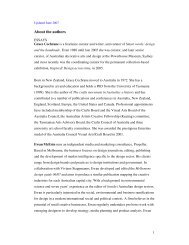History of Excavations at Olympia - Powerhouse Museum
History of Excavations at Olympia - Powerhouse Museum
History of Excavations at Olympia - Powerhouse Museum
You also want an ePaper? Increase the reach of your titles
YUMPU automatically turns print PDFs into web optimized ePapers that Google loves.
© <strong>Powerhouse</strong> <strong>Museum</strong>, Sydney, Australia, 2000<br />
1806 The Englishmen Edward Dodwell and William Gell, assisted<br />
by local labourers, exposed part <strong>of</strong> the Temple <strong>of</strong> Zeus. They<br />
revealed column drums lying in a row and part <strong>of</strong> the black<br />
floor mentioned by Pausanias in his Guide to Greece, written<br />
around 160 AD.<br />
1807 Wilkins published The Antiquities <strong>of</strong> Magna Graecia, inwhich<br />
he included a plan based on the work <strong>of</strong> Dodwell and Gell. He<br />
identified the Temple as a 6 x 13 peripteral temple.<br />
1813 Lord Spencer Stanhope and his architect Allason made a<br />
measured plan <strong>of</strong> <strong>Olympia</strong>.<br />
1830 Lt. Leake published Travels in Morea, based on his journeys in<br />
1805. He included Stanhope and Allason’s plan <strong>of</strong> <strong>Olympia</strong>.<br />
10 May 1829 Excav<strong>at</strong>ion work began under Dubois and A. Blouet <strong>of</strong> the<br />
Louvre by the French team <strong>of</strong> soldiers and scientists <strong>of</strong> the<br />
Expédition scientifique de Morée. This team had come<br />
immedi<strong>at</strong>ely after Greece had won independence from the<br />
Ottoman Empire.<br />
Work concentr<strong>at</strong>ed on the Temple <strong>of</strong> Zeus. Some fragments <strong>of</strong><br />
the metopes were found (which are now in the Louvre in Paris).<br />
Attempts were made to find the pedimental sculpture, but after<br />
realising th<strong>at</strong> the ancient ground surface lay some five metres<br />
below the current ground level, east <strong>of</strong> the Temple <strong>of</strong> Zeus,<br />
work there was abandoned.<br />
The Triton mosaic in the pronaos (front porch) was exposed, as<br />
well as two more columns and more black flooring in the<br />
interior <strong>of</strong> the Temple.<br />
Leaving the Temple, the team moved to a substantial building<br />
further west. This was the Byzantine church, which was<br />
subsequently shown to have been built in the ruins <strong>of</strong> Pheidias’<br />
workshop.<br />
No further excav<strong>at</strong>ion was permitted, although the fragments <strong>of</strong><br />
metopes and other sculptures were removed to the Louvre.<br />
The French published promptly in three volumes.<br />
1834 L. Roß was appointed the Chief Conserv<strong>at</strong>or <strong>of</strong> Antiquities in<br />
Greece by King Otto.<br />
This essay is from the <strong>Powerhouse</strong> <strong>Museum</strong>’s website “1000 years <strong>of</strong> the Olympic Games”<br />
<strong>at</strong> http://www.phm.gov.au/ancient_greek_olympics/<br />
2
















